A brushed finish features fine, unidirectional lines that create a muted, matte look, ideal for disguising fingerprints and minor scratches. Mirror finish surfaces are polished to a high gloss, reflecting light sharply and enhancing the elegance of Your stainless steel appliances or fixtures.
Table of Comparison
| Feature | Brushed Finish | Mirror Finish |
|---|---|---|
| Appearance | Matte, textured surface with visible grain lines | Highly reflective, smooth, and glossy surface |
| Scratch Visibility | Scratches blend with grain, less noticeable | Scratches and blemishes are highly visible |
| Maintenance | Easy to maintain, hides fingerprints and smudges | Requires frequent cleaning, shows fingerprints easily |
| Durability | Resists wear and tear well | More prone to surface damage and tarnishing |
| Common Applications | Appliances, kitchenware, automotive trim | Decorative items, jewelry, high-end appliances |
| Cost | Generally lower cost due to simpler finishing | Higher cost due to labor-intensive polishing |
Introduction to Metal Finishes
Brushed finish features a textured surface created by fine abrasives, producing a subtle, matte appearance that reduces visible fingerprints and scratches, commonly used in stainless steel appliances and automotive trims. Mirror finish provides a highly polished, reflective surface achieved through multiple stages of grinding and buffing, often found in decorative items and precision instruments for its aesthetic appeal. Both finishes enhance metal durability and design but serve distinct functional and visual purposes depending on application requirements.
What is a Brushed Finish?
A brushed finish is a surface texture achieved by polishing metal with a fine-bristle brush or abrasive pad, creating a consistent, linear grain pattern that reduces glare and hides scratches. This technique is commonly applied to stainless steel, aluminum, and other metals to provide a matte, satin-like appearance favored in appliances, automotive trim, and architectural elements. The brushed finish enhances durability by minimizing fingerprints and wear marks, making it highly practical for both functional and aesthetic applications.
What is a Mirror Finish?
A mirror finish is a highly polished surface with a smooth, reflective quality that resembles a glass mirror, achieved through progressive sanding and buffing. It enhances aesthetic appeal by providing a shiny, flawless look often used in stainless steel appliances, jewelry, and automotive parts. Your choice between a mirror finish and a brushed finish depends on the desired level of shine and maintenance, as mirror finishes require more frequent cleaning to preserve their luster.
Visual Differences: Brushed vs Mirror
Brushed finishes display a matte texture with fine parallel lines, creating a subdued, modern look that reduces visible fingerprints and scratches. Mirror finishes offer a highly reflective, glossy surface resembling a polished glass mirror, enhancing brightness and providing a sleek, elegant appearance. The visual contrast between the two lies in the brushed finish's muted, textured aesthetic versus the mirror finish's smooth, shiny brilliance.
Durability and Maintenance Comparison
Brushed finishes offer enhanced durability with their textured surface that effectively hides scratches and fingerprints, making them ideal for high-traffic areas or frequently handled items. Mirror finishes, while visually striking with their reflective and smooth surface, require more maintenance as they easily show smudges, scratches, and water spots. Choosing a brushed finish can reduce your cleaning efforts and prolong the appearance of wear compared to the higher upkeep needed for mirror finish surfaces.
Cost Considerations for Each Finish
Brushed finishes typically cost less due to the simpler abrasion process that hides minor scratches and fingerprints, making them ideal for functional items with moderate budgets. Mirror finishes demand higher costs because of the meticulous polishing required to achieve a reflective surface, increasing labor and material expenses. When choosing Your finish, consider the budget alongside maintenance needs since mirror finishes may incur additional costs for upkeep.
Applications: Where Each Finish Excels
Brushed finishes excel in applications requiring a muted, non-reflective surface such as kitchen appliances, automotive trim, and architectural elements, providing resistance to fingerprints and minor scratches. Mirror finishes are ideal for decorative and precision instruments, jewelry, and high-end interior designs where a highly reflective, polished surface enhances aesthetic appeal and visual impact. Each finish's application depends on the desired balance between durability, maintenance, and visual characteristics.
Design Impact: Modern vs Classic Appeal
Brushed finish offers a modern, matte texture that conceals fingerprints and scratches, giving your space a contemporary, understated elegance. Mirror finish provides a highly reflective, polished surface that enhances classic appeal with its sleek, luxurious look, creating an eye-catching focal point. Choosing between brushed and mirror finishes significantly influences the overall design impact, balancing modern minimalism against timeless sophistication.
Environmental Factors and Longevity
Brushed finishes are more resistant to scratches and fingerprints, making them ideal for environments with high traffic or exposure to harsh elements, thus ensuring longer durability. Mirror finishes, while visually stunning and reflective, tend to show scratches and smudges more easily, requiring frequent maintenance to preserve their pristine appearance. When considering your choice, think about the environmental conditions and desired longevity to select a finish that balances aesthetics and practicality.
Choosing the Right Finish for Your Project
Brushed finish offers a textured, matte look that hides fingerprints and scratches, making it ideal for high-traffic or industrial-style projects requiring durability. Mirror finish provides a highly reflective, polished surface perfect for decorative applications needing a sleek, modern appearance. Your choice depends on the balance between maintenance, aesthetic preference, and the environment in which the material will be used.
Brushed finish vs mirror finish Infographic

 libmatt.com
libmatt.com